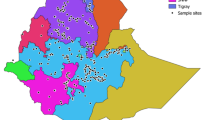Abstract
The USDA Agricultural Research Service (ARS) National Small Grains Collection (NSGC) has 207 landrace barleys obtained from a nursery grown in the Ukraine in 1930 by N.I. Vavilov, many of which have multiple resistance (MR) to disease similar to accessions from Ethiopia. The original collection locations of the accessions from the Vavilov nursery are unknown. The purpose of this study was to determine, using molecular markers, if the MR accessions of unknown origin from the Vavilov nursery are genetically related to MR accessions from Ethiopia. The genetic relatedness among susceptible accessions of unknown origin and among a selection of landrace accessions from the NSGC barley core subset was also assessed. Simple sequence repeat (SSR) and Diversity Array Technology PL (DArT) marker data were used to generate similarity matrices with Dice’s similarity coefficients. Cluster analysis from these results showed that the unknown-origin MR accessions grouped with accessions from Ethiopia. Susceptible accessions of unknown origin were genetically similar to accessions from western Asia, especially near the Caucasus, and from both southern and northern Europe. Based on similarity of marker profiles, some accessions from the core collection are likely duplicates. Future work will seek to identify the probable origin of the remainder of the unknown origin accessions and to more thoroughly characterize the genetic diversity within NSGC barley core subset.

Similar content being viewed by others
References
Bonman JM, Bockelman HE, Jackson LF, Steffenson BJ (2005) Disease and insect resistance in cultivated barley accessions from the USDA National Small Grains Collection. Crop Sci 45:1271–1280
D’Arcy C (1997) Barley yellow dwarf. In: Mathre DE (ed) Compendium of barley diseases. The American Phytopathological Society, St. Paul, pp 59–61
Dice LR (1945) Measures of the amount of ecologic association between species. Ecology 26:297–302
Jilal A, Grando S, Henry R, Lee L, Rice N, Hill H, Baum M, Ceccarelli S (2008) Genetic diversity of ICARDAs worldwide barley landrace collection. Genet Resour Crop Evol 55:1221–1230
Knüpffer H, Terentyeva I, Hammer K, Kovaleva O, Sato K (2003) Ecogeographic diversity – a Vavilovian approach. In: Von Bothmer R, van Hintum T, Knüpffer H, Sato K (eds) Diversity in barley (Hordeum vulgare). Elsevier, Amsterdam, pp 53–76
Kolodinska Brantestam A, Von Bothmer R, Dayteg C, Rashal I, Tuvesson S, Weibull J (2007) Genetic diversity changes and relationships in spring barley (Hordeum vulgare L.) germplasm of Nordic and Baltic areas as shown by SSR markers. Genet Resour Crop Evol 54:749–758
Line RF (2002) Stripe rust of wheat and barley in North America: a retrospective historical review. Annu Rev Phytopathol 40:75–118
Liu K, Muse SV (2005) PowerMarker: integrated analysis environment for genetic marker data. Bioinformatics 21:2128–2129
Macaulay M, Ramsay L, Powell W, Waugh R (2001) A representative, highly informative ‘genotyping set’ of barley SSRs. Theor Appl Genet 102:801–809
Malysheva-Otto L, Ganal MW, Röder MS (2006) Analysis of molecular diversity, population structure and linkage disequilibrium in a worldwide survey of cultivated barley germplasm (Hordeum vulgare L.). BMC Genet 7:6
Malysheva-Otto L, Ganal M, Law J, Reeves J, Röder M (2007) Temporal trends of genetic diversity in European barley cultivars (Hordeum vulgare L.). Mol Breed 20:309–322
Pandey M, Wagner C, Friedt W, Ordon F (2006) Genetic relatedness and population differentiation of Himalayan hulless barley (Hordeum vulgare L.) landraces inferred with SSRs. Theor Appl Genet 113:715–729
Rohlf FJ (2005) NTSYS-pc: numerical taxonomy and multivariate analysis system version 2.2. Setauket. Exeter, New York
Russell JR, Ellis RP, Thomas WTB, Waugh R, Provan J, Booth A, Fuller J, Lawrence P, Young G, Powel W (2000) A retrospective analysis of spring barley germplasm development from `foundation genotypes’ to currently successful cultivars. Mol Breed 6:553–568
Schaller CW, Qualset CO, Rutger JN (1963) Sources of resistance to the yellow-dwarf virus in barley. Crop Sci 3:342–344
Steffenson BJ (1997) Net blotch. In: Mathre DE (ed) Compendium of barley diseases. The American Phytopathological Society, St. Paul, pp 28–31
United Nations (2000) World Macroregions and Components [Online]. http://www.un.org/depts/dhl/maplib/worldregions.htm (verified 27 April, 2010)
Varshney RK, Salem KFM, Baum M, Röder MS, Graner A, Börner A (2008) SSR and SNP diversity in a barley germplasm collection. Plant Genet Resour 6:167–174
Vavilov NI (1997) Five continents: International Plant Genetics Resources Institute, Rome
Weber JL (1990) Informativeness of human (dC-dA)n (dG-dT)n polymorphisms. Genomics 7:524–530
Wenzl P, Carling J, Kudrna D, Jaccoud D, Huttner E, Lleinhofs A, Kilian A (2004) Diversity arrays technology (DArT) for whole-genome profiling of barley. Proc Natl Acad Sci USA 101:9915–9920
Xia L, Peng K, Wenzl P, Carmen de Vincent M, Fregene M, Kilian A (2005) DArT for high-throughput genotyping of Cassava (Manihot esculenta) and its wild relatives. Theor Appl Genet 110:1092–1098
Yahiaoui S, Igartua E, Moralejo M, Ramsay L, Molina-Cano J, Ciudad F, Lasa J, Gracia M, Casas A (2008) Patterns of genetic and eco-geographical diversity in Spanish barleys. Theor Appl Genet 116:271–282
Zhang LY, Marchand S, Tinker NA, Belzile F (2009) Population structure and linkage disequilibrium in barley assessed by DArT markers. Theor Appl Genet 119:43–52
Author information
Authors and Affiliations
Corresponding author
Rights and permissions
About this article
Cite this article
Bonman, J.M., Gu, Y., Coleman-Derr, D. et al. Inferring geographic origin of barley (Hordeum vulgare L. subsp. vulgare) accessions using molecular markers. Genet Resour Crop Evol 58, 291–298 (2011). https://doi.org/10.1007/s10722-010-9574-4
Received:
Accepted:
Published:
Issue Date:
DOI: https://doi.org/10.1007/s10722-010-9574-4




